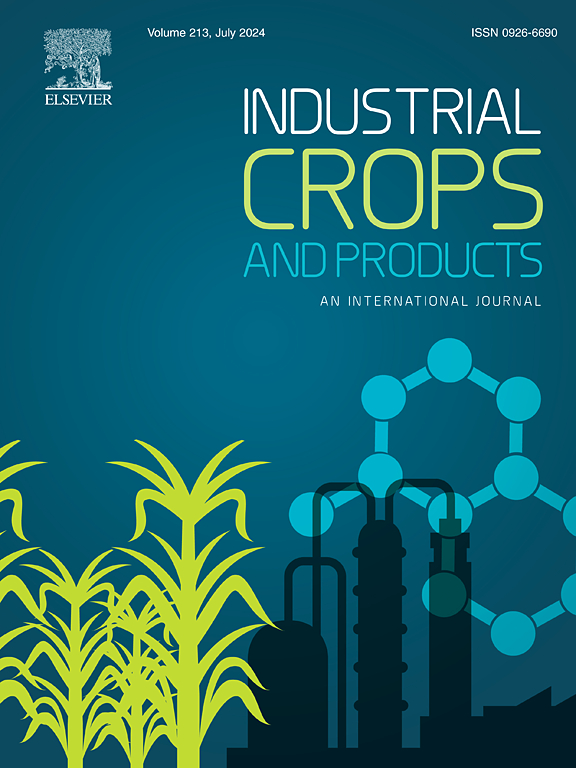IF 5.6
1区 农林科学
Q1 AGRICULTURAL ENGINEERING
引用次数: 0
摘要
唐古特茴香是一种罕见的药用植物,可产生临床上重要的托烷生物碱:茴香碱、茴香胺、东莨菪碱和阿托品,但由于野生资源稀缺和耕作方式欠佳,其可持续栽培面临挑战。众所周知,P 的添加会影响次生代谢物,但微生物组对生物碱合成的影响尚不清楚。因此,在本研究中,我们通过设定磷添加梯度(LP:120 kg/hm2;MP:180 kg/hm2;HP:240 kg/hm2),系统分析了磷对唐古特芒柄鱼生物碱含量与微生物组之间关联的机制。结果表明,添加 P 能显著降低根、茎和叶中 4 种生物碱的含量。虽然微生物α-多样性仍然没有反应,但却引起了微生物群落的结构重组,包括根瘤菌和大体积土壤细菌,它们与生物碱有明显的关联,通过氮循环和有机物分解途径加剧了养分竞争。与此同时,真菌群落中致病功能的丰度也随着 P 的添加而显著增加。本研究证明,钾的添加通过双重途径抑制生物碱的积累:(1)土壤中 C:N:P 的化学计量失衡干扰了植物次生代谢的资源分配;(2)病原真菌的引入阻碍了生物碱在植物体内的合成和积累。这些发现为通过减少化肥用量和提高化肥利用率来栽培唐古牛提供了理论依据。研究表明,药用植物的精确施肥需要考虑土壤养分的平衡和微生物功能的调节。通过抑制病原菌群和优化土壤益生菌的数量,可以减少磷肥的施用量,同时提高药用有效成分的产量,这对实现民族药用资源的可持续利用具有重要的实用价值。本文章由计算机程序翻译,如有差异,请以英文原文为准。
Integrated microbiological and metabolomic analyses reveal the mechanism by which P addition affects the quality of Anisodus tanguticus
Anisodus tanguticus, a rare medicinal plant producing clinically vital tropane alkaloids: anisodine, anisodamine, scopolamine, and atropine, faces challenges in sustainable cultivation due to wild resource scarcity and suboptimal farming practices. While P addition is known to influence secondary metabolites, its microbiome mediated effects on alkaloid synthesis remain unclear. Therefore, in this study, we systematically analysed the mechanism of P on the association between alkaloid content of Anisodus tanguticus and microbiome by setting P addition gradients (LP: 120 kg/hm2, MP: 180 kg/hm2, HP: 240 kg/hm2). The results demonstrated that P addition significantly reduced the content of 4 alkaloids in roots, stems and leaves. While microbial α-diversity remained unresponsive, but induced a structural reorganization of the microbial community, encompassing rhizosphere and bulk soil bacteria, which exhibited a marked association with alkaloids, intensified nutrient competition through the nitrogen cycling and organic matter catabolism pathways. Concurrently, the abundance of pathogenic functions within the fungal community underwent a significant increase with P addition. In this study, it was demonstrated that the addition of P inhibits alkaloid accumulation through dual pathways: (1) soil C:N:P stoichiometry imbalance interferes with plant secondary metabolism resource allocation; and (2) the introduction of pathogenic fungi hinders alkaloid synthesis and accumulation in plants. These findings provide a theoretical basis for the cultivation of Anisodus tanguticus by reducing the amount and increasing the efficiency of chemical fertilisers. The study suggests that precise fertilisation of medicinal plants needs to take into account the balance of soil nutrients and microbial function regulation. By suppressing the pathogenic bacterial flora and optimising the abundance of soil probiotic bacteria, it is possible to reduce the amount of phosphorus fertiliser applied and at the same time increase the yield of medicinal active ingredients, which is of great practical value in achieving the sustainable use of ethnomedicinal resources.
求助全文
通过发布文献求助,成功后即可免费获取论文全文。
去求助
来源期刊

Industrial Crops and Products
农林科学-农业工程
CiteScore
9.50
自引率
8.50%
发文量
1518
审稿时长
43 days
期刊介绍:
Industrial Crops and Products is an International Journal publishing academic and industrial research on industrial (defined as non-food/non-feed) crops and products. Papers concern both crop-oriented and bio-based materials from crops-oriented research, and should be of interest to an international audience, hypothesis driven, and where comparisons are made statistics performed.
 求助内容:
求助内容: 应助结果提醒方式:
应助结果提醒方式:


